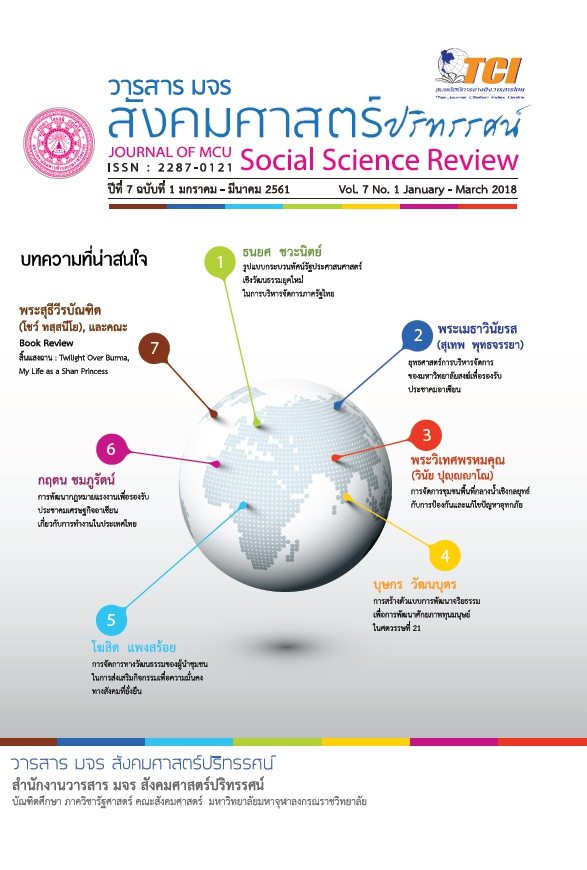การพัฒนาการบริหารจัดการโรงเรียนวิถีพุทธในจังหวัดสมุทรปราการ
บทคัดย่อ
บทความเรื่อง “การพัฒนาการบริหารจัดการโรงเรียนวิถีพุทธในจังหวัดสมุทรปราการ”
มีวัตถุประสงค์เพื่อ 1) ศึกษาแนวคิดและทฤษฎีที่เกี่ยวกับการพัฒนาการบริหารจัดการโรงเรียนวิถีพุทธ 2) ศึกษาสภาพทั่วไปของการพัฒนาการบริหารจัดการโรงเรียนวิถีพุทธในจังหวัดสมุทรปราการ และ 3) นำเสนอการพัฒนาการบริหารจัดการโรงเรียนวิถีพุทธในจังหวัดสมุทรปราการ โดยใช้การวิจัยแบบผสานวิธี ระหว่างการวิจัยเชิงคุณภาพ และการวิจัยเชิงปริมาณ การวิจัยเชิงคุณภาพ ดำเนินการโดยสัมภาษณ์เชิงลึกผู้ให้ข้อมูลสำคัญ 20 คน และการสนทนากลุ่มเฉพาะ จำนวน 12 คน ซึ่งเลือกแบบเจาะจง วิเคราะห์ข้อมูลด้วยการวิเคราะห์เนื้อหาประกอบบริบท การวิจัยเชิงปริมาณ ดำเนินการโดยสำรวจกลุ่มตัวอย่าง 400 คน ซึ่งสุ่มด้วยวิธีสุ่มอย่างง่าย
จากประชากรจำนวน 2,786 คน ซึ่งเป็นผู้บริหาร ครู บุคลากร และนักเรียน ของโรงเรียนวิถีพุทธในจังหวัดสมุทรปราการ เครื่องมือที่ใช้ในการเก็บข้อมูลได้แก่ แบบสอบถามแบบประมาณค่า 5 ระดับ ที่ระดับความเชื่อมั่น 0.951 สถิติที่ใช้ในการวิเคราะห์ข้อมูลได้แก่ ค่าความถี่ ค่าร้อยละ ค่าเฉลี่ย และค่าส่วนเบี่ยงเบนมาตรฐาน
ผลการวิจัย พบว่า
1) โรงเรียนวิถีพุทธ เป็นโรงเรียนที่นำหลักธรรมทางพระพุทธศาสนามาใช้หรือประยุกต์ใช้ในการบริหารและการพัฒนาผู้เรียน ผู้เรียนได้พัฒนาการกิน อยู่ ดู ฟัง ให้เป็น และนำเอาหลักธรรมทางพุทธศาสนามาประยุกต์ใช้ในการบริหารและการจัดการเรียนการสอน ได้แก่ อิทธิบาท 4
สัปปายะ 7 อริยสัจ 4 ไตรสิกขา และพรหมวิหาร 4
2) การพัฒนาการบริหารจัดการโรงเรียนวิถีพุทธในจังหวัดสมุทรปราการ ด้านการกายภาพ ผู้ตอบแบบสอบถามเห็นว่ามีการปฏิบัติอยู่ในระดับที่สูงที่สุด รองลงมาคือด้านกิจกรรมพื้นฐานวิถีชีวิต ส่วนที่มีระดับการปฏิบัติน้อยที่สุด คือด้านบรรยากาศและปฏิสัมพันธ์ ทั้งนี้อาจเป็นเพราะไม่ค่อยได้สนทนาปราศรัยกัน หรือจัดกิจกรรมร่วมกันมากเท่าที่ควร
3) การพัฒนาการการบริหารจัดการโรงเรียนวิถีพุทธในจังหวัดสมุทรปราการนั้น พบว่า
3.1) การพัฒนาด้านการบริหารจัดการ ควรร่วมกันวางแผนและกำหนดนโยบาย มอบหมายหน้าที่และความรับผิดชอบอย่างชัดเจน และกำหนดให้บุคลากรทุกคนได้มีส่วนร่วม พร้อมทั้งนำหลักอิทธิบาทธรรม 4 มาบูรณาการ
3.2) การพัฒนาด้านกายภาพ บ้าน วัด โรงเรียน ร่วมกันระดมทุนเพื่อปรับสภาพแวดล้อมให้เหมาะสม ส่งเสริมการดำเนินชีวิตตามแนววิถีพุทธ สร้างความเข้าใจในวิถีชีวิตและวัฒนธรรมแบบวิถีพุทธ พร้อมทั้งจัดสภาพแวดล้อมให้เป็นไปตามหลักสัปปายะ 7
3.3) การพัฒนาด้านกิจกรรมพื้นฐานวิถีชีวิต ทุกฝ่ายควรตระหนักถึงความสำคัญของกิจกรรมพื้นฐานวิถีชีวิต ประพฤติตนให้เป็นแบบอย่างที่ดี แลกเปลี่ยนเรียนรู้ซึ่งกันและกัน จัดสรรเวลาให้เหมาะสมกับทุกๆ ฝ่าย จัดกิจกรรมบูรณาการตามหลักอริยสัจ 4 อย่างมีเหตุผลในการแก้ไขปัญหา
3.4) การพัฒนาด้านการเรียนการสอน ควรกำหนดหลักสูตรให้มีความสอดคล้องกับวิถีพุทธ บุคลากรของโรงเรียน ควรเป็นต้นแบบในการเรียนรู้ที่ดี พัฒนาบุคลากรให้มีความรู้ความเข้าใจในหลักธรรมอย่างแท้จริง เน้นการปฏิบัติ เพื่อให้เกิดการนำไปใช้จริงในชีวิตประจำวัน จัดการเรียนการสอนตามหลักไตรสิกขา
3.5) การพัฒนาด้านบรรยากาศและปฏิสัมพันธ์ บุคลากรของโรงเรียน ควร สร้างความเป็นกัลยาณมิตร ด้วยการยิ้มแย้มแจ่มใสทักทายกัน ส่งเสริมการมีปฏิสัมพันธ์ที่ดี โดยบูรณาการกับหลักพรหมวิหาร 4
เอกสารอ้างอิง
Chaiwat Uthaisaenchut. (2012). School Safety Management Strategies (Doctor of Philosophy Thesis). Graduate School: Silpakorn University.
Department of Academic Affairs. (2003).National Economic and Social Development Board Ninth National Economic and Social Development Plan 2002-2006 Bangkok: Siam Sport.
Phrakrusangharak Kiettisak Kittipañño. (2015). Model of Buddhist Leadership Development in Organization Management of Mahachalalongkorn-
rajavidyalaya University. Journal of MCU Social Science Review, 4(2) (Special Issue), 212-227.
Office of Educational Innovation Development Ministry of Education. (2005). Guidelines for the implementation of Buddhist schools. Bangkok: Ministry of Education.
Sirima Monmai. (2011). Educational Administration for Children's Rights in Secondary Schools under the UN Convention on the Rights of the Child (Doctor of Philosophy thesis). Graduate School: Silpakorn University.
Sutthiphong Siwichai and Grop. An Analysis of School Style in Buddhism: A Case Study of Buddhist Schools in 10 Educational Areas (Research Report). Faculty of Education: Mahachulalongkornrajavidyalaya University.
Suwari Siriphokhaphirom. (2003). Educational Research. Lopburi: Printing Department, The Rajabhat Institute.
ดาวน์โหลด
เผยแพร่แล้ว
รูปแบบการอ้างอิง
ฉบับ
ประเภทบทความ
สัญญาอนุญาต
ลิขสิทธิ์ (c) 2019 วารสาร มจร สังคมศาสตร์ปริทรรศน์

อนุญาตภายใต้เงื่อนไข Creative Commons Attribution-NonCommercial-NoDerivatives 4.0 International License.
เพื่อให้เป็นไปตามกฎหมายลิขสิทธิ์ ผู้นิพนธ์ทุกท่านต้องลงลายมือชื่อในแบบฟอร์มใบมอบลิขสิทธิ์บทความให้แก่วารสารฯ พร้อมกับบทความต้นฉบับที่ได้แก้ไขครั้งสุดท้าย นอกจากนี้ ผู้นิพนธ์ทุกท่านต้องยืนยันว่าบทความต้นฉบับที่ส่งมาตีพิมพ์นั้น ได้ส่งมาตีพิมพ์เฉพาะในวารสาร มจร สังคมศาสตร์ปริทรรศน์ เพียงแห่งเดียวเท่านั้น หากมีการใช้ภาพหรือตารางหรือเนื้อหาอื่นๆ ของผู้นิพนธ์อื่นที่ปรากฏในสิ่งตีพิมพ์อื่นมาแล้ว ผู้นิพนธ์ต้องขออนุญาตเจ้าของลิขสิทธิ์ก่อน พร้อมทั้งแสดงหนังสือที่ได้รับการยินยอมต่อบรรณาธิการ ก่อนที่บทความจะได้รับการตีพิมพ์ หากไม่เป็นไปตามข้อกำหนดเบื้องต้น ทางวารสารจะถอดบทความของท่านออกโดยไม่มีข้อยกเว้นใดๆ ทั้งสิ้น





